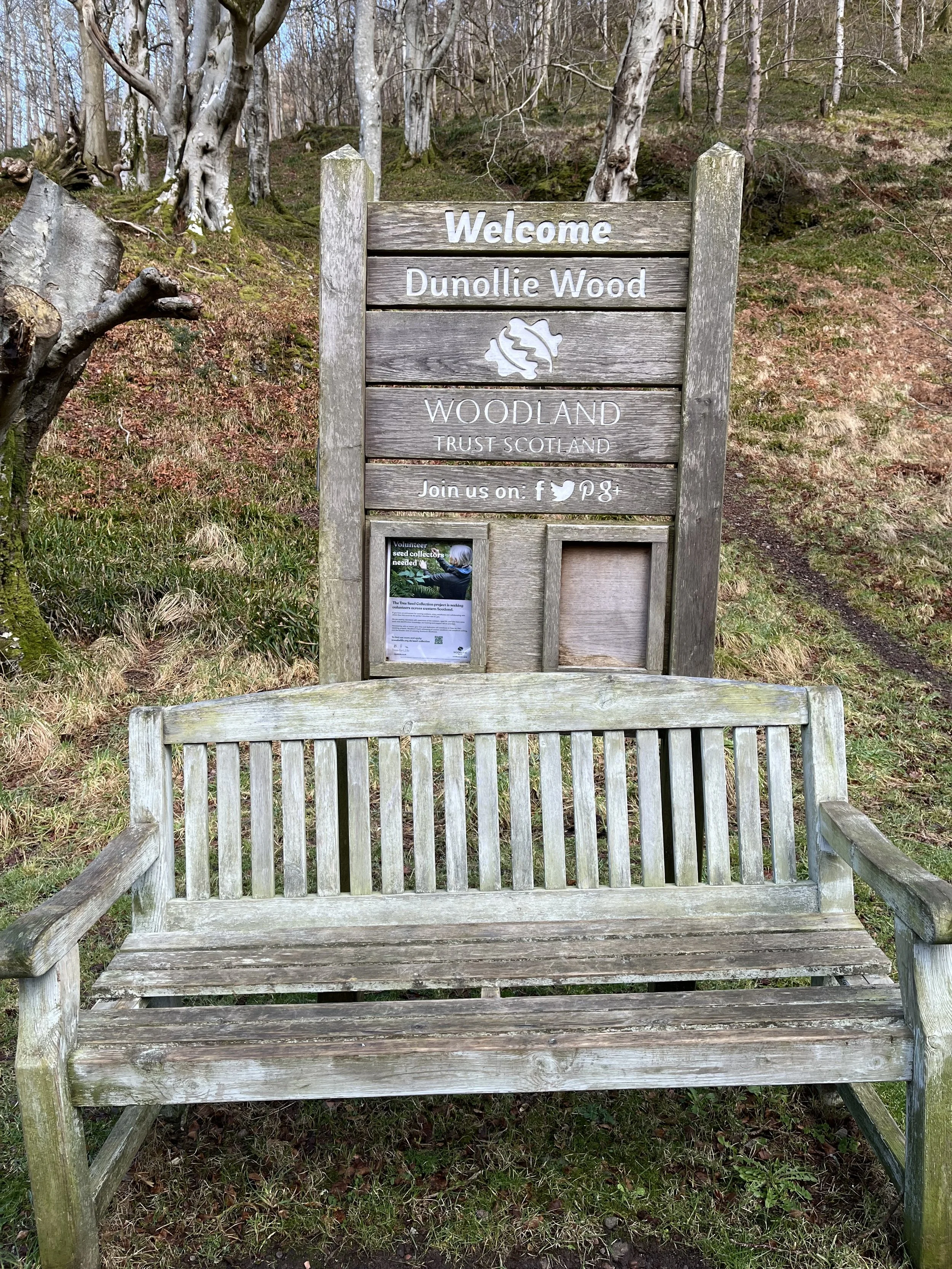An unexpected rainforest
Dunollie Wood is situated right in the heart of Scotland’s busiest port town, and yet it’s somehow managed to retain much of its special rainforest biodiversity. Jenny Tweedie went exploring there this February, and was in for a bit of a surprise.
One of the entrances to Dunollie Wood
Patches of Scotland’s rainforest can be found scattered up and down the west of Scotland. But many of the most biodiverse (those with the greatest range of species) are found in really remote and difficult-to-access locations. That’s because their incredible collections of lichens, mosses and liverworts prefer not to be disturbed: they grow slowly, and spread slowly, and that’s just not compatible with a fast-moving or ever-changing habitat.
Lack of disturbance is usually found where there are fewer people (because we’re fast moving and constantly change habitats), which is why you don’t see rainforests near cities or towns. They need peace and quiet to just silently sit and soak up the rain over many hundreds of years.
Except as it turns out, rainforest woodlands can on rare occasions survive in built-up places, clinging on where there’s just enough tranquillity to keep all those mosses and lichens happy. Sometimes this can be as little rainforest as a single tree, or a small group of trees. But sometimes, a larger scrap of woodland can hang on. In biological terms, these surviving patches of rainforest are called ‘refugia’.
The mysterious woodland with lichens hanging off every tree
Dunollie: the urban rainforest
Oban is a bustling town, not particularly big (population 8,000) but it’s Scotland’s busiest port, with ferries coming and going throughout the day. It’s also on the West Highland Line, and is a jumping off point for hillwalkers looking for a Munro or two to bag.
Dunollie Wood is a firmly embedded part of Oban, growing in and around its houses, and rising up on the hillside behind the town, making it an unmissable and iconic part of the visual landscape. When you walk around its lower reaches, it appears to be little different from the woodland you might walk around in any Scottish town: a mix of native and non-native trees, many planted purposefully by the owners and managers of the site over hundreds of years.
But scramble up the steep, slippery slope of the hill to its summit, and you encounter a hidden rainforest that’s a true survivor, clinging on in a semi-urban environment, despite the years of disturbance all around it.
Here the woodland is transformed. It no longer feels man-made (outside that nagging sense you’ve accidentally wandered onto the set for a fantasy film) and the trees are no longer alone. They’re festooned in lichens, which dangle off the branches like weird gothic Christmas decorations. Pretty much every tree is covered, and because it was February when I visited, there were no leaves in competition, altering the vibrant green of a woodland to soft grey.
But the out and out star of this wood is its hazel trees, which have their own special ecosystem of lichens going on.
Yellow specklebelly and frilly-fruited jelly skin
Hazels aren’t like other trees that grow with a trunk and then stemmed branches. Instead, their branches grow up from a central stump or ‘stool’. These stools can live for a long time, while individual stems can live for about 50-100 years. New stems are always growing, so one tree will have stems of all different ages.
This means a single hazel tree can offer lots of different habitats all at the same time, and when the hazel is growing in Scotland’s rainforest, it can host a massive range of different lichens. Some lichens prefer the wrinkled bark found on old stems, while others prefer the smooth bark found on young stems.
When you see a rainforest hazel like this, every branch is fascinating, and you could spend ages looking and never spot everything. The hazels at Dunollie even host some of the rarer rainforest species, like yellow specklebelly, and others that are instantly recognisable indicator species, such as the frilly-fruited jelly skin.
Rainforest hazels like these also sometimes attract a type of fungus called the glue-crust fungus. This weird species operates by sticking branches together (often a dead branch to a living branch) and they then feed on the decaying wood. Sometimes, a second fungus will take up home on the glue-crust fungus and feed off that. These fungi are called hazel-gloves, (because they grow looking like fingers, and are soft like leather to the touch) and there are one or two examples of these at Dunollie too.
Red squirrels and other species
As well as the lichens and the fungi, Dunollie hosts a wide range of other wildlife, some of which (sadly) can only be seen from spring until autumn, such as rare butterflies, and migrant birds. However, one iconic Scottish species was very much in evidence as we wandered around: the super-cute red squirrel.
Often associated with Caledonian pinewoods, red squirrels are actually quite at home in the rainforest, and we spotted three without even looking that hard, more than I’ve seen in a long time.
The future of Dunollie Wood
Dunollie Wood is managed by Woodland Trust Scotland, one of the originating partners of the Alliance for Scotland’s Rainforest. They recognise its importance as a surviving fragment of rainforest, and are working to protect and restore it for the future, as well as keeping the site accessible to the local people who use and love this woodland.
But like many rainforest woodlands, the issues it faces are complex. There are, for example, a large number of non-native trees that will need to be felled and removed over the next few years. The logistics of this are challenging, given the location and the terrain, and the Woodland Trust is also seeking to restore the wood in a way that’s sympathetic to the visual landscape.
There’s a lot of planting to do as well, in areas where trees were previously felled. You can’t plant temperate rainforest, unfortunately. But the joy of all those licheny, hazel refugia is that they hold the promise of the rainforest spreading into newly planted areas sometime in the future, maybe with a little help from all those red squirrels.
Experience Dunollie for yourself
If you live in Oban and have never seen the rainforest hazels, all I can say is that it’s worth the climb. It is steep, and I struggled on one or two sections, but I’m really glad I made it. I’m just sad I couldn’t spend more time with the lichens!
If you’re just passing through Oban, it’s also worth a look, and a full walk round Dunollie (which you can enter from behind the Corran Halls) only takes a couple of hours. I’m told the bluebells are stunning in the spring, and I’m sorry to have missed that.
Just be gentle with this special place. Don’t trample off the beaten path, keep dogs under close control, and please, please, respect those brilliant lichens!
Find out more about the site here: https://www.woodlandtrust.org.uk/visiting-woods/woods/dunollie-wood/









